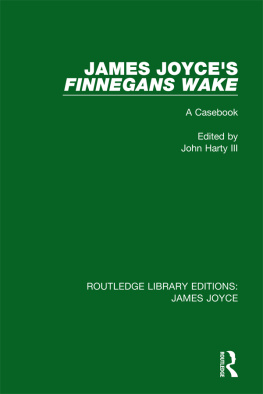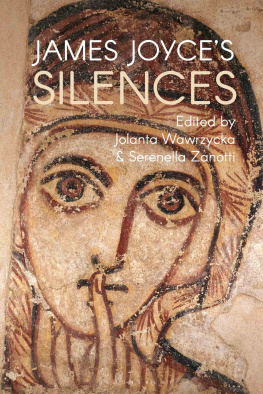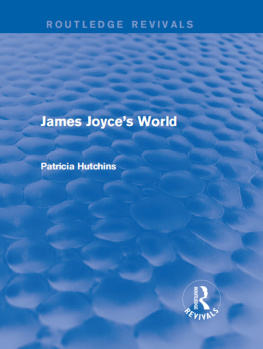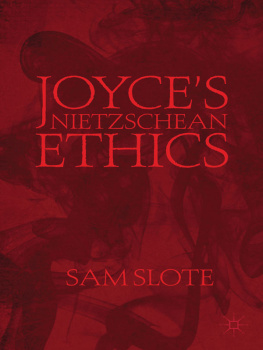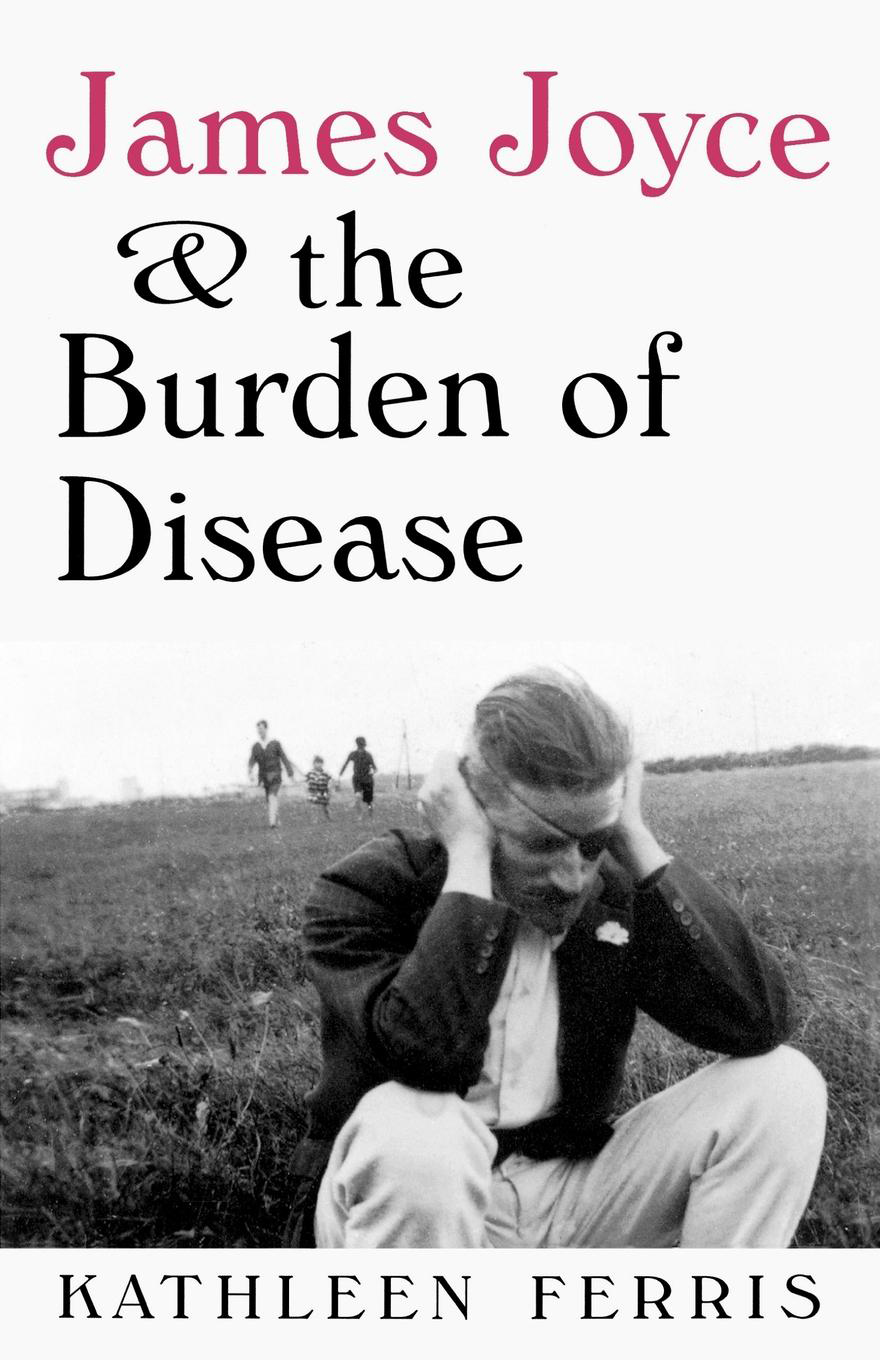JAMES JOYCE
& the
BURDEN
OF DISEASE

JAMES JOYCE
& THE
BURDEN OF
DISEASE
Kathleen Ferris

Frontispiece: Photograph of James Joyce courtesy of
the Beinecke Rare Book and Manuscript Library, Yale University Library.
Copyright 1995 by The University Press of Kentucky
Paperback edition 2010
The University Press of Kentucky
Scholarly publisher for the Commonwealth,
serving Bellarmine University, Berea College, Centre
College of Kentucky, Eastern Kentucky University,
The Filson Historical Society, Georgetown College,
Kentucky Historical Society, Kentucky State University,
Morehead State University, Murray State University,
Northern Kentucky University, Transylvania University,
University of Kentucky, University of Louisville,
and Western Kentucky University.
All rights reserved.
Editorial and Sales Offices: The University Press of Kentucky
663 South Limestone Street, Lexington, Kentucky 40508-4008
www.kentuckypress.com
The Library of Congress has cataloged the hardcover edition as follows:
Ferris, Kathleen, 1941
James Joyce and the burden of disease / Kathleen Ferris.
p. cm.
Includes bibliographical references (p. ) and index.
ISBN 0-8131-1893-X
1. Joyce, James, 18821941Health. 2. Novelists, Irish20th
centuryBiography. 3. SyphilisPatientsIrelandBiography.
4. Venereal diseases in literature. 5. Body, Human, in literature.
6. Syphilis in literature. 7. Health in literature. I. Title.
PR6019.09Z533378 1994
823.912dc20
[B]94-19905
ISBN-13: 978-0-8131-2664-7 (pbk.)
This book is printed on acid-free recycled paper meeting
the requirements of the American National Standard
for Permanence in Paper for Printed Library Materials.

Manufactured in the United States of America.

| Member of the Association of
American University Presses |
Contents
Illustrations
Acknowledgments
First, my thanks to Oliver D. Gogarty, son of Oliver St. John Gogarty, for his consent to my quoting from the letters of his father; to Erwin Ellmann, brother of Richard Ellmann, for his permission to quote from the Ellmann correspondence and interviews; to Margaret Gibson Phillips, daughter of Desmond Harmsworth, for permission to reproduce the sketch Joyce at Midnight; and to the Board of Trinity College, Dublin, for permission to reproduce two images from The Book of Kells. Thanks also to Yale University Library for authorizing use of manuscript materials and the photograph of Joyce that appears on the dust jacket, all of which are located in the Beinecke Rare Book and Manuscript Library; to the Harry Ransom Humanities Research Center for permission to use the sketch Joyce at Midnight; to The Poetry/Rare Books Collection, University Libraries, State University of New York at Buffalo for permission to cite manuscripts; and to the Cornell University Library for permission to cite manuscripts from the Division of Rare and Manuscripts Collections.
Further, I wish to express my debt to the many people whose assistance and encouragement have made this book possible:
First, my gratitude to three eminent Joyceans who gave very generously of their time to read and critique the manuscript in its earlier stages. Morton Levitt, Fritz Senn, and the late Bernard Benstock offered corrections, advice, and criticisms that have helped me to strengthen my argument and have, I hope, saved me from future embarrassment. Whereas I am deeply indebted to them all, I claim all remaining deficiencies of the book as my own.
Also I wish to thank the medical doctors who have given so much of their time, expertise, and library resources to help me understand the complexities of fields of study not my own. My opthalmologist, Dr. Harold Akin, spent many hours reviewing the medical and literary evidence with me, and without his assistance and encouragement I might have abandoned this project in its early stages. Dr. Frank Carter, an internist, twice read my third chapter to check the medical information, as did Dr. Harold Akin and Dr. J. Howard Young, my gynecologist. The late Dr. Rudolph Kampmeier kindly spent an afternoon reviewing my evidence and explaining to me the symptoms and cycles of a disease that he had spent many years of his life treating before the advent of penicillin. Dr. Hansreudi Isler listened to my ideas and tried to assist me from Zurich. Psychologist Richard L. Saylor, who works with schizophrenics, discussed with me the manifestations of that disease and provided me with valuable literature. Drs. Mark Simpson, Howard Simpson, Robert Sanders, and Harold Akin also lent me textbooks from which I launched my medical study.
My doctoral committee at Emory University played a crucial role in the early stages of this endeavor. My director, Dr. Ronald Schuchard, gave me encouragement and, perhaps more important, the freedom to follow my own ideas, providing his knowledge of Joyce and Joycean scholarship to guide me. Dr. James Flannery, with his broad knowledge of Ireland and of the literature of the period, gave my work close critical reading and offered me invaluable advice on how to get it published. Dr. Georgia Christopher was a careful editor who played the Devils Advocate with a vengeance.
My school, Lincoln Memorial University, and the Faculty Scholars Program at the University of Kentucky enabled me to attend Joyce conferences, thus providing me the opportunity to present my ideas to a forum of Joyce scholars.
Librarians at many schools have given me kindly assistance, for which I am very grateful: Dr. Thomas Staley, Research Librarian Cathy Henderson, and Barbara LaBorde at the Harry Ransom Humanities Research Center of the University of Texas at Austin; Mr. Sidney F. Huttner and his staff at the McFarlin Library of the University of Tulsa; James Tyler, Lucy Burgess, and Elaine Engst at the Division of Rare and Manuscript Collections of Cornell University; Dr. Robert Bertholf and his staff at The Poetry/Rare Books Collection, University Libraries, State University of New York at Buffalo; and Doris Dysinger and her staff in Special Collections at Bucknell University. Also the interlibrary loan departments at Emory University (Margaret Whittier), Middle Tennessee State University (Almyra Medlin and Betty McFall), and Lincoln Memorial University (Karen Loving) have obtained for me many books and articles to which I would not otherwise have had access.
My friends and family also have given me support, moral and intellectual, physical and financial, enabling me to persevere in this task. My colleagues at Lincoln Memorial University, especially my chair, Dan DeBord, and my buddies David Sprague and Kay Davis, have offered me encouragement in my scholarly efforts. My friend Whitney Stegall has assisted me financially. Wera Howard and Nancy Rupprecht translated an article for me. Ginny Vesper obtained books. Bill Geissler and Diti Geissler lent me a computer, and my brother Arthur later built one for me, without which this book would never have been completed. Many friends, such as John Juricek, Linda Magee, Bascom Williamson and Mitsue Williamson, and the Geisslers, have listened patiently while I have expounded my ideas. My father-in-law, Paul Ferris, read through rough drafts and offered sound editorial advice, as did my husband, Norman, who also bought me books, ran errands, obtained articles, tended children, dogs, cats, and plants, cooked dinner, and hardly complained. My children have humored me. My mother has been proud of me. This work is the result of the contributions of many.



